Art
Art Exhibition "Out of Control"
September 29, 2016 - October 02, 2016
HfG | University of Arts and Design
Lorenzstraße 15
76135 Karlsruhe
Friday - Sunday // 10 a.m. - 6 p.m.
Vernissage: September 29 // 6.30 p.m.
Global-is(ol)-ation
3D-installation by Gülsel Özkan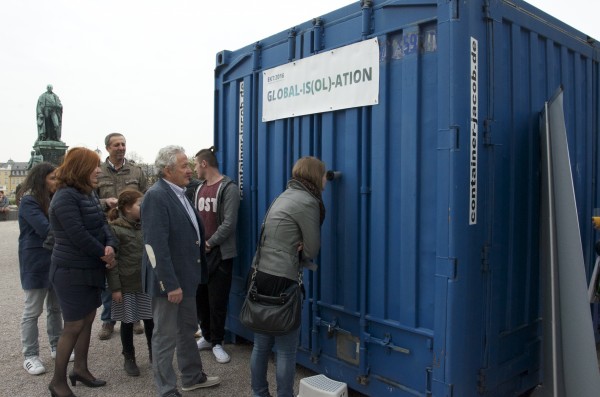
The container - a symbol of globalisation. With its simple form, it is used as a transportation medium with high recognition value - but no one actually knows what it keeps inside. Hidden in the dark, it does not only transport goods, but also refugees. They have all had a long journey and left everything of what they loved behind, hoping for a better life. Through an opening, the inner of the container can be seen. Inside, stereoscopic monitors show refugees as 3 dimensional paintings visualizing their wait. The spatial depth effect causes the impression of a real-life encounter. With "Global-is(ol)-ation", Gülsel Özkan enables an insight into the inner of those containers, which reduces human beings to transport good.
Further impressions about this installation can be found here.
Time machine
Interactive multimedia installation by Marco Sanna
Hidden inside an advertising pillar in a public space, there is a time machine, which plays with speed, interactive combinations and compositions, contrasts, external procurements, cross-references, zeitgeist and sense of time. Appearing white from the outside - simple, neutral and timeless - it seems like a blank sheet and at the same time transient. Inside, one will perceive a multimedia experience, where time and outer environment will be forgotten. By means of a rotating wheel, the time traveler turns within a closed pillar accompanied by sound-, video- and LED-compositions through several eras and innovations. These compositions deal with the time before the big bang, the big bang itself as well as the formation of the earth. The time travel continues with the emergence of life, the human evolution and their development of machines. Thus, the intensive connection ad well as interactions between human beings and machines can be experienced. The time machine demonstrates the future and enables a travel through the black hole. The cycle closes by repeating the big bang.
Embrace Me
3D-stereoscopic video installation by Arent Weevers (2012)
A baby emerges from the deep black, floating very slowly towards you. His open attitude and outstretched arms invite you to embrace him. The baby then detaches from the void, floating for a moment as a fragile sculpture – timeless and silent in space. Slowly, he disappears back into the darkness. The whole is accompanied by a richly dissonant score, sound and image evoking multiple associations. Feelings of fragility, beauty and desolation merge for an experience of quiet intensity.
Music: David Dramm
Further impressions about this installation can be found here.
Ecce Homo
3D-holographic installation by Arent Weevers (2015)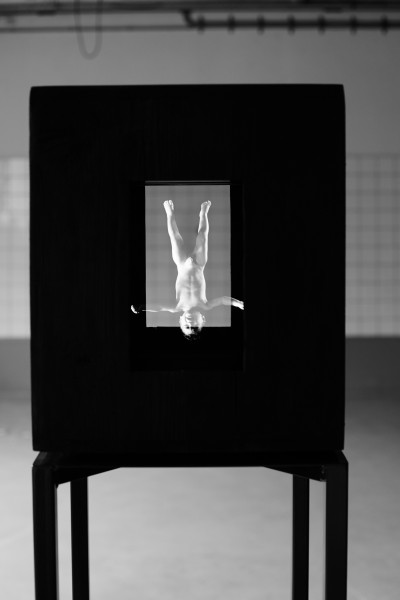
The title “Ecce Homo” (“Behold the Man”) refers to the biblical story John. In this 3D holographic video installation the passage from the Passion of Jesus is given a contemporary touch. Without the crown of thorns and the purple robe, not an innocent young man but a naked little boy in all his pain and sorrow is shown to the “world”, floating upside down.
Music: David Dramm
Further impressions about this installation can be found here.
walk 4 me
Project by Hannah Cooke (2016) 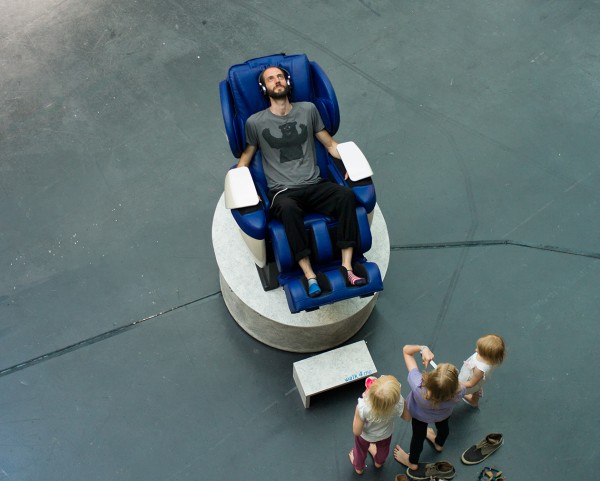
An independently motorized massage armchair, which includes an audio guide, leads the visitor gently through an exhibition. Driven by a programmed motor within an electric wheelchair, the visitor will be drawn into a unique and exciting challenge. The automatic motorized armchair follows a route determined by an inductive guidance system. The visitors will have no influence as to the speed neither of the armchair, where it will stop nor to the distance to the artworks. The audio guide, which is based on guided meditations from the wellness and spa industry, prepares the visitor mentally for the visit to the exhibition. The gentle voice encourages reflection on the individual’s position within the exhibition and enables the visitor to become relaxed and receptive.
Further impressions about this work can be found here.
Synaescape II
Real time interactive audio-video installation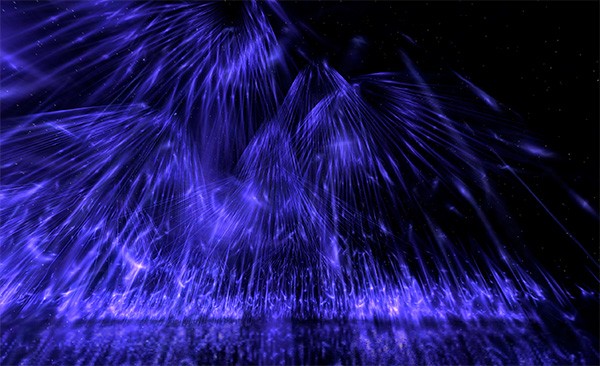 by Vesna Petresin
by Vesna Petresin
with Rubedo
The installation creates otherworldly, playful and sensual landscapes, made of crystalline light structures that react by playing musical loops when triggered by visitor’s movement. Visitors can choreograph them as first-person user. The artists developed a real-time interactive artistic medium, defined as ‘synaescape’. The immersive single-player installation is entered through a portal to a virtual landscape, which evolves and responds to the viewer as one engages with it. The artists approach architectural space as fluid rather than solid, composing with space and sound, which aims to recreate Goethe’s notion of ‘crystallized music’. Using particle field simulations, in which every point in space is connected to an action in time, they create a kind of a 4-dimensional instrument.
AutoGraff
Video of an algorithmic graffiti installation 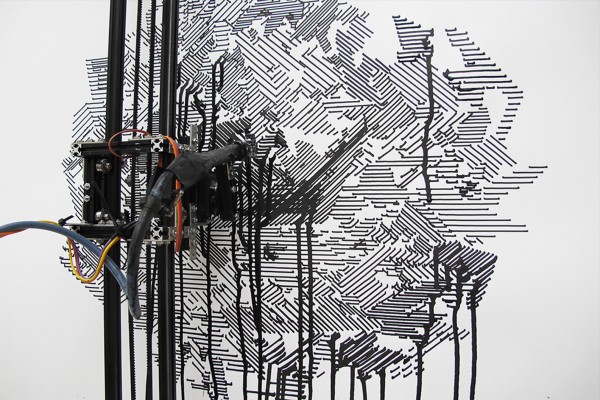
by Daniel Berio & Frederic Fol Leymarie (2013-15)
The installation documents an algorithmic graffiti installation, which creates graffiti pieces based on the drawing style of its creator, Daniel Berio. Resulting from years of experience as a graffiti artist, Daniel created this system during his ArtScience research as an attempt to merge the aesthetics of his own style of graffiti letters with algorithmic art. He developed generative graffiti algorithms whose output is fed to physical drawing machines and augmented with real-time projections, mixing real ink with projected light as a painterly medium. The system becomes a familiar extension of the artist and his style into the computational medium, allowing the same stylization principles specific to graffiti letters to be applied to different types of visual media. The works generated by the machine have a strong resemblance to the work that would be executed manually by the artist, and the stylistic signature of graffiti is well recognizable also by peer graffiti artists.
Biomechanics Noordung
Video installation by Cosmokinetic Cabinet Noordung (2001-16)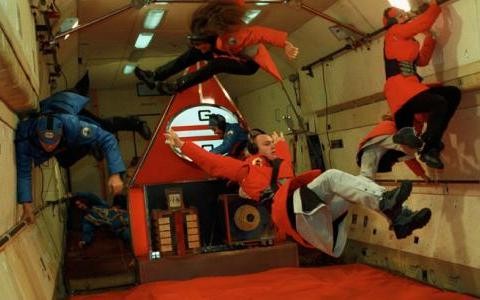
On December 15 1999, Dragan Zivadinov’s Cosmokinetic Cabinet Noordung Theatre performed "Biomechanics Noordung" in a Russian cosmonaut training aircraft. The performance by Zivadinov involved actors that performed in zero gravity for 1 minute. The public was not included, but the performance was filmed. The actors worn special costumes redesigned from the time of Meyerhold theater research, and the internal space of the aircraft was re-arrange into a theater space, decorated with objects from the Russian constructivist art period, which flourished immediately after the October socialist revolution, around 1920. The performance "Biomechanics Noordung" consisted of a repetition of choreographed Biomechanics movements and the investigation of new technological and electronic means through the intersection of theatre, the body, mobility, subjectivity and mechanics, with more general social phenomena and their realities, and especially with contemporary theories of the physiological changes of the human skeleton at zero gravity.
Longing and Forgetting
Generative audio-video installation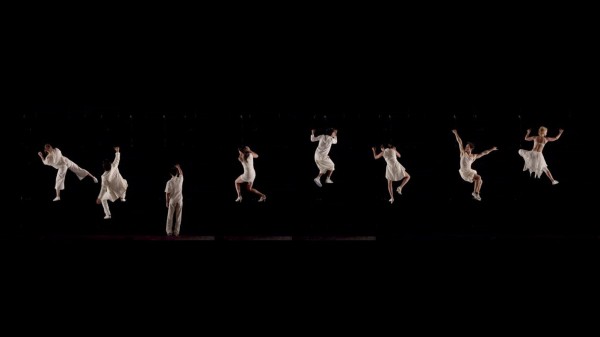
by Philippe Pasquier, Thecla Schiphorst & Matt Gingold (2015)
Artificial Intelligence is omnipresent. From video games to online love, from driving cars, flying planes, online trading to state-of-the-art military strategy - the notion of 'artificial agent' is now the prevalent paradigm to embodying machines in virtual or robotic bodies. “Longing and Forgetting” is a generative audio video installation, exploring the idea of generative choreographies amongst multiple 'video agents' or 'digital performers'. Using a simple movement 'alphabet' that borrows from Laban concepts such as effort, weight, and space, 12 physical performers were filmed traversing a climbing wall. This resulted in thousands of video clips which were analysed and tagged according to basic movement properties. As such, each 'video agent' is equipped with its elementary movements, which can be stitched together with rules that govern their goals and actions and are able to emerge complex structures and choreographies.
Hyper-Reality
16:9 format HD video, 6 minutes 16 seconds, 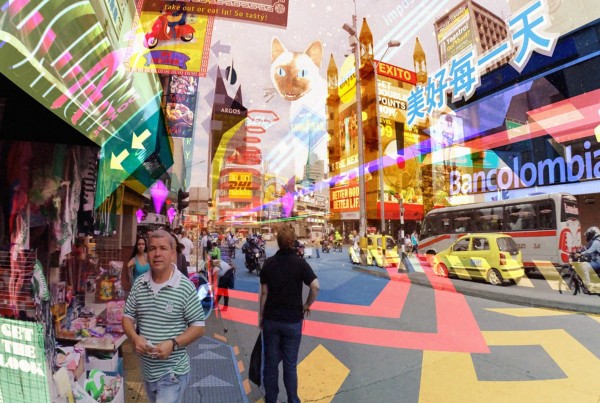
by Keiichi Matsuda (2015-16)
"Hyper-Reality" is a concept film presenting a provocative and kaleidoscopic new vision of the future, where physical and virtual realities have merged, and the city is saturated in media. It is the latest work in an ongoing research-by-design project by Keiichi Matsuda; previous works include Domestic Robocop, Augmented City 3D and Keiichi’s master thesis Domesti/city. Our physical and virtual realities are becoming increasingly intertwined. Technologies such as VR, augmented reality, wearables, and the internet of things are pointing to a world where technology will envelop every aspect of our lives. It will be the glue between every interaction and experience, offering amazing possibilities, while also controlling the way we understand the world. "Hyper-Reality" attempts to explore this exciting but dangerous trajectory. It was crowdfunded, and shot on location in Medellín, Colombia.
Robots of Brixton
16:9 format HD video, 5 minutes 35 seconds, by Kibwe Tavares (2011)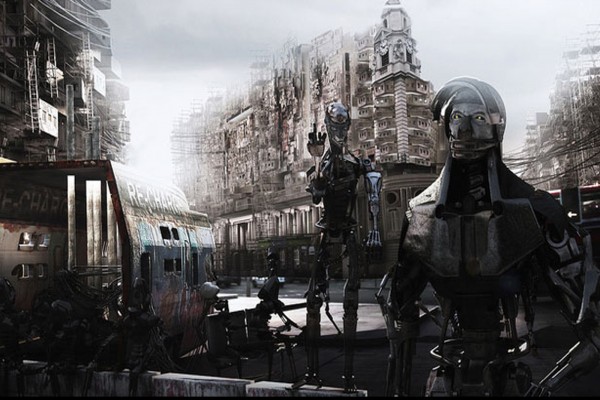
“Robots of Brixton” is an architectural film project that explores the relationship between architecture, class and race. Using Brixton (or an augmented Brixton) as backdrop, the project uses robots as metaphors for a future intake of migrants to the UK. It acts as a commentary on the cyclical nature of the working class in areas with diverse populations, such as Brixton. The project shows Brixton as a degenerated and disregarded area inhabited by London's new robot workforce. The robots are built and designed to carry out all of the tasks which humans are no longer inclined to do. The mechanical population of Brixton has rocketed, resulting in unplanned, cheap and quick additions to the skyline. The film follows the trials and tribulations of young robots surviving at the sharp end of inner city life, living the predictable existence of a populous hemmed in by poverty, disillusionment and mass unemployment. "Robots of Brixton" bridges architecture and politics, using the medium of film as an open and accessible way in.
Waves
Single channel ultra wide HD video installation, 3 minutes 35 seconds, 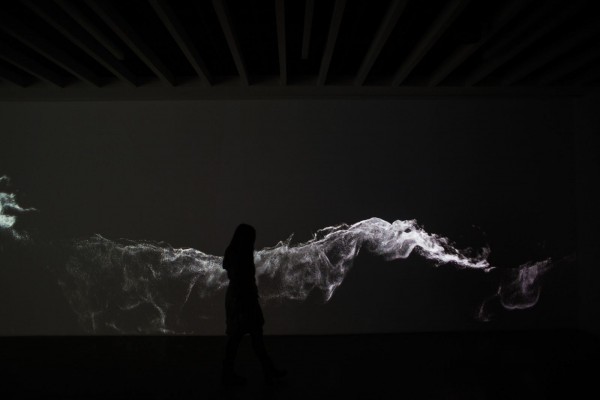
by Memo Akten (2015)
This installation is part of the "Waves"-series. Inspired by the well-established history of both artistic and scientific study on oceans and oceanic waves, "Waves" is a data dramatization of complex ocean simulations, distilled and re-imagined in the form of abstract visuals and sounds. It is an ongoing series of studies that investigate the tension and delicate balance between the immense power and incredible fragility of the oceans: simultaneously mighty yet delicate, calming yet terrifying, graceful yet violent, a symbol of fear, danger and death as well as hope, freedom and life. This particular edition was made during the aftermath of the tragic November 2015 Paris killings, and the consequent public and political thirst to bomb Syria in retaliation, which in turn would inevitably trigger an opposing retaliation.
Cloud Sediment (Gstaad), 2016
Sean Snyder, cryptographic time stamp: September 25, 2016 19:47:01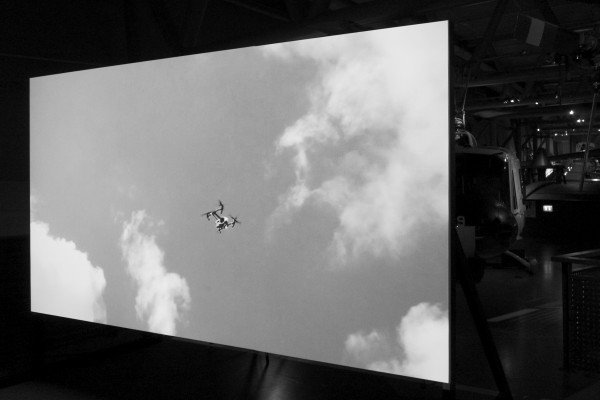
16:9 format HD video, 7 minutes 47 seconds, b/w and color, audio, 180 cm x 320 cm projection
Sean Snyder further explores the visual paradoxes of (im)materiality of information, focusing on the Swiss ‘Fort Knox’, the data center that is supposed to withstand natural disasters, terror, hacker attacks and even atomic explosions. Shot in Gstaad, Switzerland, the images alternate between snowy Alpine land and air-scapes, using the fragile apparatus that produces the images and the color of achromatic post-Cold War bunkers that contain gold of the information age. Geometrically scanning the inorganic landscape, the video reflects digital deterritorialization and its solid hardware basis, eliciting the opposition between the inside and outside.
SwarmReflief
16:9 format HD video, 53 seconds, by Robert Stuart-Smith / Kokkugia, 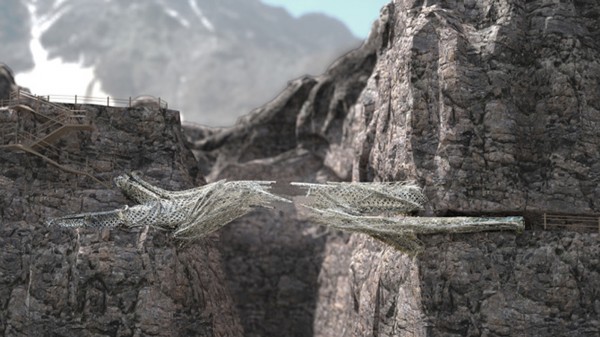
with Maria Chiou (2016)
The experimental sculpting proposes a non-standard construction process created by a swarm of 3D-Printing UAVs (unmanned aerial vehicles), merging design and production within a singular process, based on the behaviors of robotic systems and composite materials. In contrast to conventional construction techniques, the research harnesses drone technologies in order to propose a construction process that can be pre-designed yet allow for flexibility in order to be implementable within a variety of environments through real-time structural feedback. Another experiment employs quadcopters to work as a real-time on-site design and construction swarm. The swarm performs in an autonomous and choreographed manner, adapting to the spatial specifics of the environment. Fabricating in-situ ensures that a 3-dimensional weave of threads is constructed that is not achievable with conventional factory weaving machines. The ability to spatially adapt to any site and construct through aerial robotics offers new opportunities for architectural design.
Mayur
Visual-music work by Vibeke Sorensen (2015)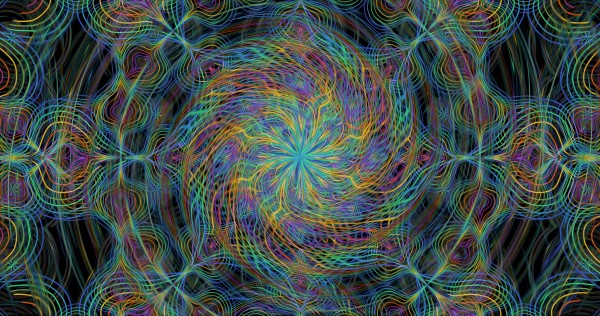
Mayur, which means “peacock” in Sanskrit, is a visual-music work inspired by Asian cosmologies, music and textiles. It is a motion painting created by digital animation featuring complex images that evolve from threads to roots and intricate vines, forming lace-like 2 and 3 dimensional structures, tiles, and living textiles in the luminous colours of a peacock. The animation is by Vibeke Sorensen and the music is by sitar virtuoso Kartik Seshadri.
SoL - Symmetries of Light
Interactive installation with panoramic projection 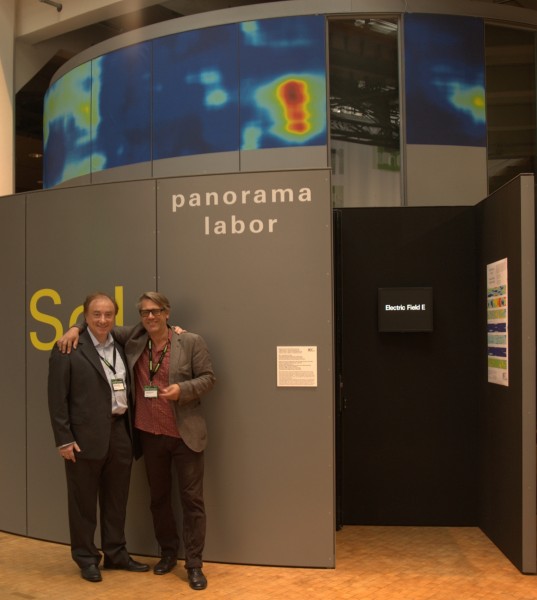
by Fabrizio Tamburini & Freddy Paul Grunert (2016)
We cannot perceive electric and magnetic fields directly except through light. They are also manifested in lightning and magnetic and electrostatic phenomena. Such fields encode hidden properties in terms of symmetries and conserved quantities - internal symmetries and invariants under space-time transformations, which are revealed by the mathematical structure of Maxwell’s equations. Inside the panorama screen installation “SoL” we are part of a two-dimensional, toroidal magnetic universe, populated by electric fields, magnetic fields, and fields of light. This universe, created by manipulating the interface, reveals the fields and invariants encrypted in Maxwell’s equations: in this electromagnetic universe, we explore and play with the invisible symmetries.
Venomenon
2-Channel S3D video installation, 11 minutes, by Elke Reinhuber
What if Orpheus had not turned his head, as he tried to rescue Eurydice from the underworld? Inspired by the myth and the potential interpretations Elke Reinhuber examines specifically the act of the look back and the resultung counterfactual thoughts with her current work, the S3D installation »Venomenon«, which has already passed several iterations as a work-in-progress. On two opposite projection screens subtly varying interpretations of the classic story are shown, abducting the viewer into the stunning architecture of Singapore – balancing between utopia and dystopia, between the past and the unknown. Another layer provides data, which can only be seen by means of scientific imaging: particulars that refer to physical states or quantify emotions and visualise internal processes. In this finely woven network of viewing angles and ambiguous meanings the audience will be forced to participate directly in the film installation.
Camera: Martin Morlock
Camera Assistance: Dominic Thiel
Cast: Katharine Crane, Jamil Schulze, Kevin Lagrange
Costume: Galina Mihaleva
Contact
Interested? Questions? Call us:
+49 (0)721 / 8100 6001
or write us:
info@beyond-festival.com





